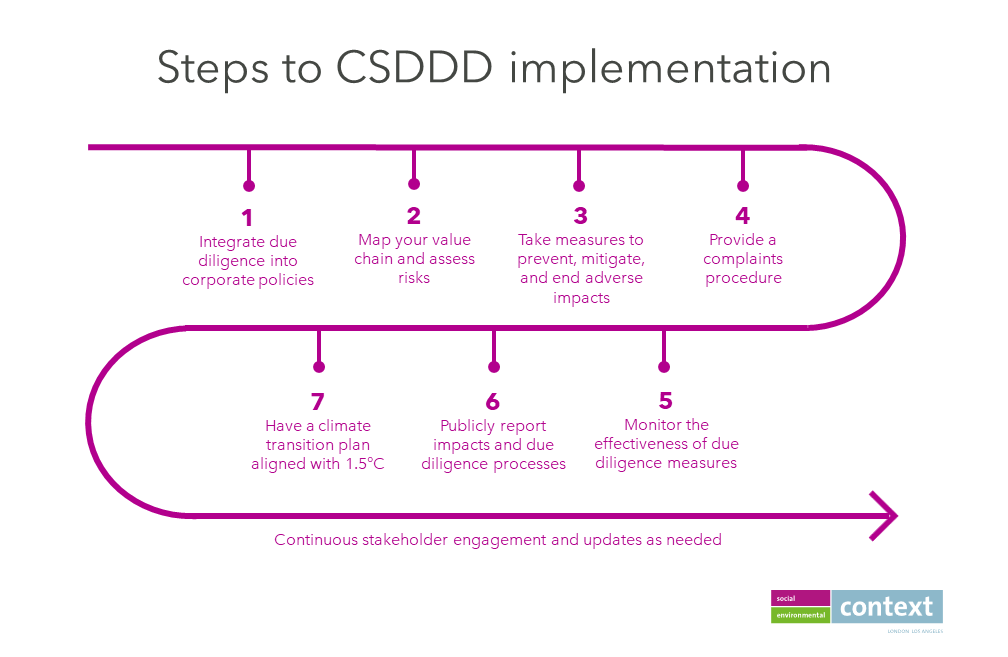The Corporate Sustainability Due Diligence Directive (CSDDD) is the new kid on the block for many large companies active in the EU: here are the key things you need to know now.
What is CSDDD?
The CSDDD (CS3D) is a new EU human rights and environment due diligence legislation that applies to large companies operating in the EU. It requires processes be embedded in the business to identify, prevent, reduce, and end negative human rights and environmental impacts in their operations, subsidiaries, and value chains — both inside and outside Europe.
Is your company subject to CSDDD?
Two types of companies need to comply:
- EU-based companies with 1,000+ employees and a global net turnover of €450+ million.
- Non-EU-based companies with a net turnover of €450+ million in the EU.
Companies must comply by 2027, 2028, or 2029 depending on number of employees, global turnover amount, and whether they’re based in the EU or not.
What are the key steps to implementation?
1. Integrate due diligence into corporate policies
Make sure that due diligence is integrated into all relevant policies and risk management systems. You also need to have a specific policy that ensures risk-based due diligence.
2. Map your value chain and assess risks
It’s crucial to get an understanding of where your company’s actual and potential impacts lie. Start by mapping your value chain to identify areas with adverse impacts and risks, and prioritise them based on likelihood and severity. Then companies must carry out in-depth assessments of individual suppliers in prioritised areas.
3. Take measures to prevent, mitigate, and end adverse impacts
Preventing and ending adverse impacts on human rights and the environment is the core of the CSDDD. Companies should implement the following:
- Human rights and environmental strategies.
- Responsible purchasing practices — including assurances to comply with minimum standards, and supplier screening and assessments.
- Corrective measures and termination of business relationship as a last resort.
- Employee and supplier training.
- Stakeholder engagement.
- Targeted and proportionate support for business partners who are SMEs, including fair and non-discriminatory contractual assurances.
4. Provide a complaints procedure
Companies must provide a notification system which is accessible to potentially affected stakeholders and their representatives — including NGOs and human rights defenders, for example. The complaints procedure should be fair, publicly available, accessible, and transparent. Workers and their representatives must be informed of the procedure.
5. Monitor the effectiveness of due diligence measures
Periodically assessing your due diligence measures will help you see if they’re suitable and effective. Update your due diligence policy and measures as needed.
6. Publicly report impacts and due diligence processes
Compliance with CSRD means compliance with CSDDD reporting requirements. Companies must produce a publicly available annual statement on the potential and actual adverse impacts identified and due diligence measures taken.
7. Have a climate transition plan aligned with 1.5°C
Combat climate change with a transition plan aligned with limiting global warming to 1.5°C. If you’re complying with CSRD then your climate strategy is already ticked off the list.
What’s the connection to CSRD?
They are both new EU sustainability regulations covering social and environmental factors and applying to the operations and value chains of large companies. Both require public disclosure and a climate transition plan aligned with the Paris Agreement.
But while the CSDDD focuses on preventing and ending negative effects, the CSRD focuses on transparent disclosure.
For a more in-depth analysis of the overlap between CSRD and CSDDD, watch out for our upcoming blog on how they match up.
What can you do now to get started?
The first step is to familiarise yourselves with the CSDDD requirements to understand if, when and how you must comply. Assessing existing due diligence roles, policies and management systems will help you understand your gaps and establish any roles and responsibilities needed. The next step is to map your value chain to identify and prioritise risks based on likelihood and severity.
Once you understand where your biggest risks are, devise a plan to set up the necessary due diligence measures, engaging with both internal and external stakeholders. The strategy should include: in-depth supplier risk assessments, measures to prevent and mitigate impacts, grievance mechanisms, assessments to monitor due diligence processes, annual reporting, and a climate transition plan in line with the Paris Agreement.
Context is ready to support you with all your CSDDD needs — from value chain mapping and devising due diligence strategies, to writing policies and CSRD / CSDDD-aligned reports. If you would like to talk about your organisation’s needs, please get in touch via www.contextsustainability.com or helen.fisher@contexteurope.com.

